Project Design
Alternative Development
In determining how to address the needs of the project, several constraints were taken into consideration:
- The Dock Street Dam is north of and in close proximity to the South Bridge particularly at the eastern end of the bridge; widening or replacement to the north of the existing structure would not be reasonable as it would impact the dam.
- The bridge currently carries over 125,000 vehicles per day and is congested during peak rush hour periods; maintaining traffic during construction is of concern.
- Constructing the new northbound lanes to the south of the existing structure while maintaining traffic on the existing bridge makes sense. Traffic can then be shifted to the new structure, while the existing bridge is demolished, and the new southbound lanes built in its place and traffic redistributed.
- At the touchdown of the bridge on the east shore, constraints to consider during construction include: the Shipoke Historic District, Capital Area Greenbelt trail, Amtrak and Norfolk Southern rail lines, and the the Front Street Sewage Pumping Station facility.
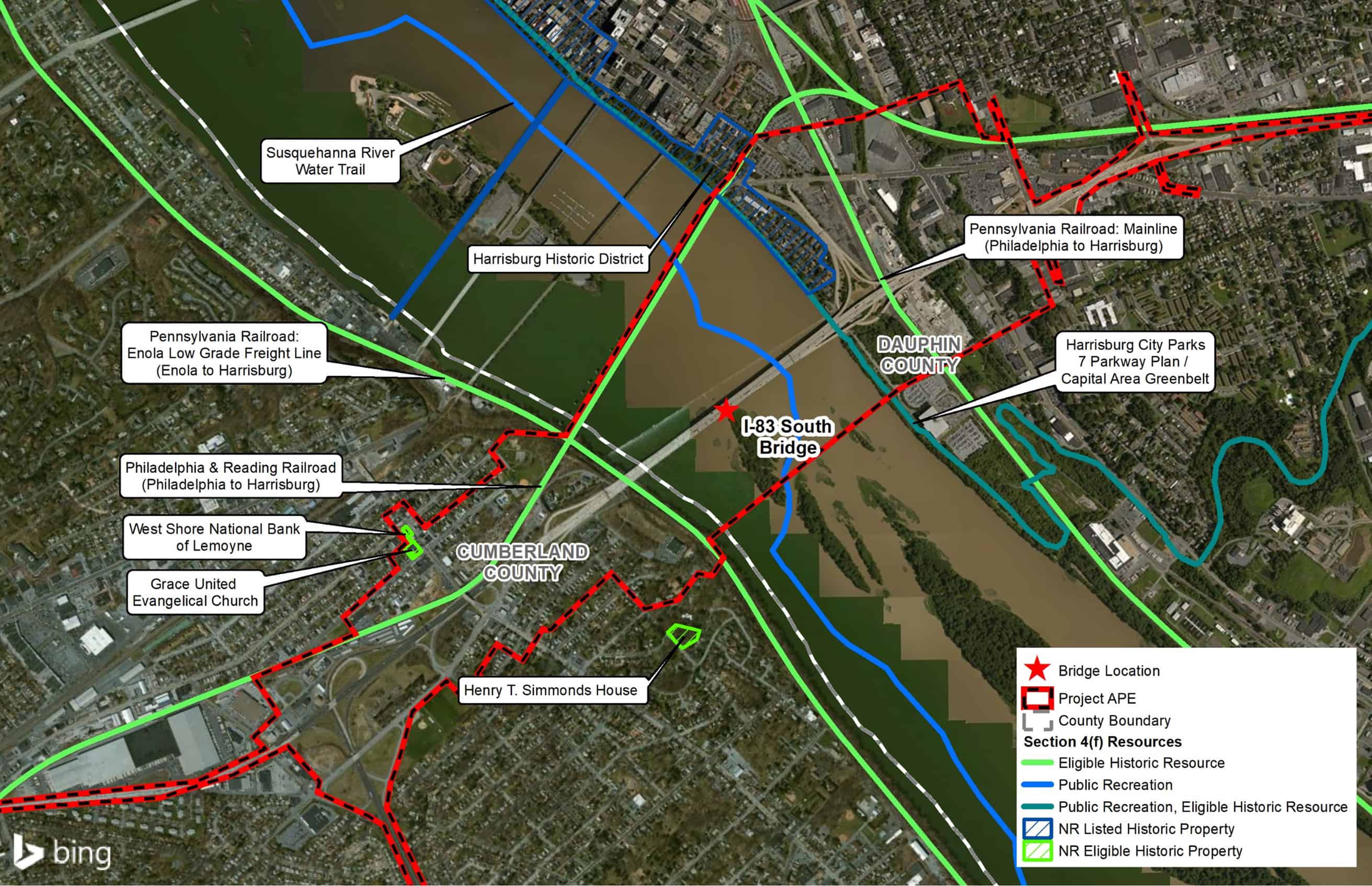
When designing how the new expanded bridge would tie into existing roadways on the west shore, we addressed several key considerations.
- Since the bridge is proposed to be widened to the south, I-83 on the west shore would also need to be widened to the south.
- Widening I-83 to the south would require realignment of Lowther Street, shifting it behind the buildings on the east end of Lowther Street to connect at Susquehanna Court. By realigning Lowther Street, access to the Lemoyne Borough wastewater facility and offices in the area would be maintained without routing traffic through the neighborhood on Walton Street.
- The Norfolk Southern Railroad parallels I-83 to the north constraining the redesign of the interchange on the west shore.
- Due to the widening of I-83 on the west shore, the South Third Street bridge over I-83 would need to be lengthened to accommodate additional lanes under the bridge. An offline replacement of the South Third Street bridge is proposed to allow for traffic to be maintained on the existing bridge during construction. With this relocation of South Third Street, the on-ramp to I-83 North would be shifted to the west beyond South Third Street, in the same location it had been before the 2015 redesign. The on-ramp would need to be shifted to accommodate the proposed I-83 widening and realignment of Lowther Street.
- The off-ramp from I-83 South would run parallel to the interstate, crossing over the railroad tracks before intersecting with South Third Street near Plum Street.
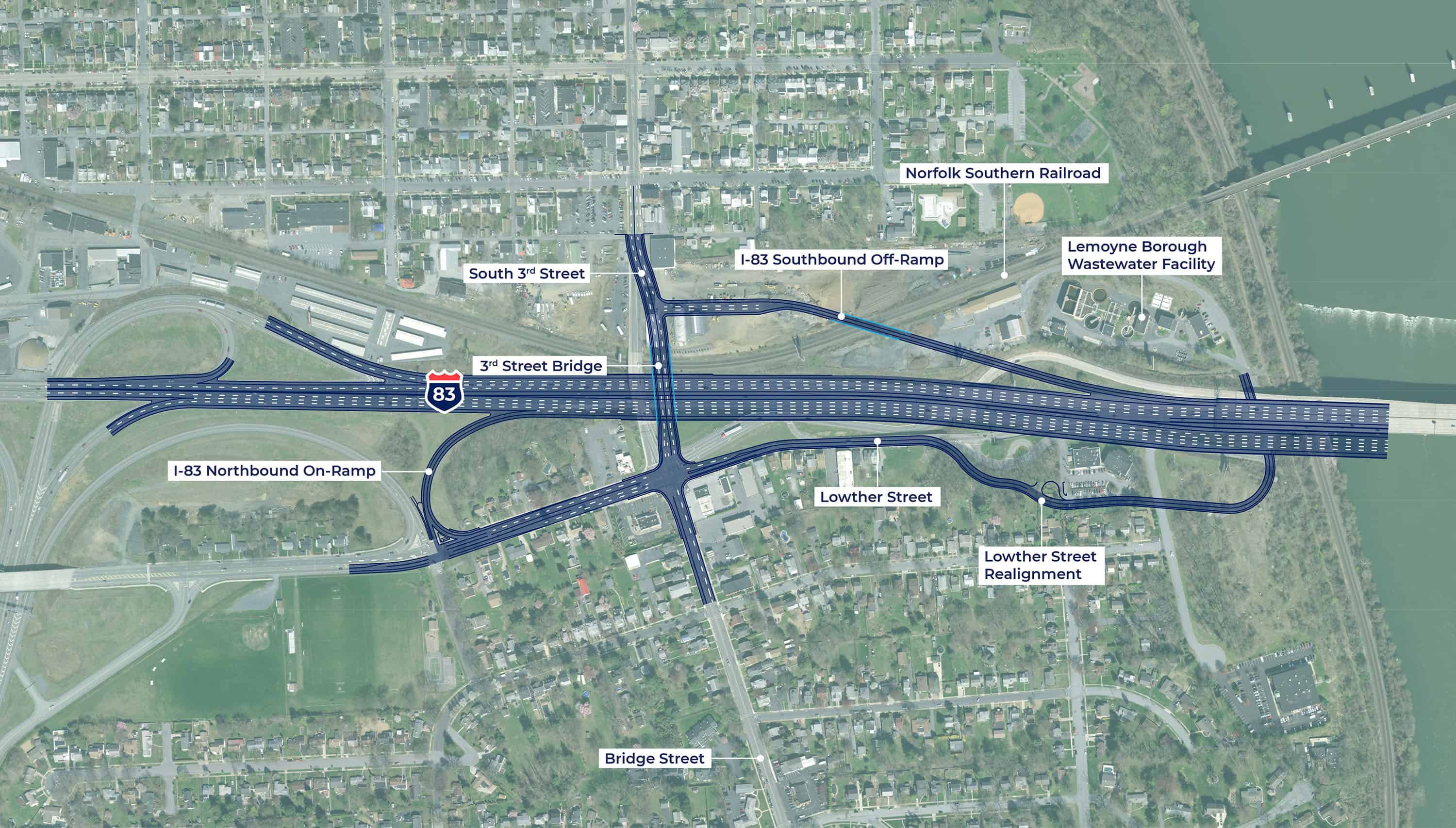
Proposed Project Design
The I-83 South Bridge Project is part of the larger I-83 Master Plan to update the Capital City Beltway around Harrisburg through a series of projects aimed at improving traffic operations and safety. The project directly east of the I-83 South Bridge Project is the East Shore Section 3 Project (ESS3), which previously included the construction of the east shore viaduct.
As we continue the process of analyzing and developing the I-83 South Bridge Project, we have determined that combining the construction of the east shore viaduct into the construction of the I-83 South Bridge could maximize construction efficiency, reduce overall costs, shorten construction duration, and minimize impacts to traffic and other resources during construction. These efficiencies are estimated to result in savings of approximately $70 million. Therefore, the proposed I-83 South Bridge project will now incorporate the area from the eastern end of the South Bridge to Cameron Street, including the viaduct and the Front Street/2nd Street Interchange.
 Click to view project plan map larger.
Click to view project plan map larger.
Bridge Construction
Typical sections showing the phases of traffic flow during construction are shown below. You can see that the proposed bridge design is widened to accommodate future growth in traffic volumes and has wider shoulders to increase safety on the bridge.
Current Bridge
This is the existing I-83 South Bridge.

Bridge During Construction
New northbound lanes would be built first, south of the existing structure. Once complete, all traffic would be routed to these new lanes. The existing bridge would then be demolished, and new southbound lanes would be built where the existing bridge was.

Bridge After Construction
Once the new southbound lanes are complete, the new South Bridge would be finished. At this time, traffic would be redistributed to their appropriate lanes.

South Third Street Bridge
To accommodate I-83's wider design the South Third Street bridge would need to be lengthened. Given the volume of traffic on South Third Street, the bridge would be reconstructed immediately east of the existing bridge, allowing traffic to use the existing bridge during construction. The eastern replacement minimizes impacts to businesses in the area. This bridge widening would improve bicycle and pedestrian accommodations and connectivity in the area. You can view the proposed changes in the typical section below.
Current South Third Street
This is the existing South Third Street Bridge.

South Third Street After Construction
The proposed design includes wider shoulders and sidewalks to accommodate pedestrians and bicyclists.

Bridge Aesthetics
What will the new South Bridge look like?
The final design plans are not complete, but here are some sample renderings of what the new South Bridge might look like.
Alternative A is a multi-girder bridge alternative, which could use either concrete or steel girders. A few views of the Alternative A design are shown below.
Bird's eye view in daytime of multi-girder bridge alternative from the west shore.

Closeup from the Riverwalk on the east shore during daytime of multi-girder bridge alternative.
 Dock Street dam shown on the right side of the image.
Dock Street dam shown on the right side of the image.
Closeup from the Riverwalk on the east shore during nighttime of multi-girder bridge alternative.
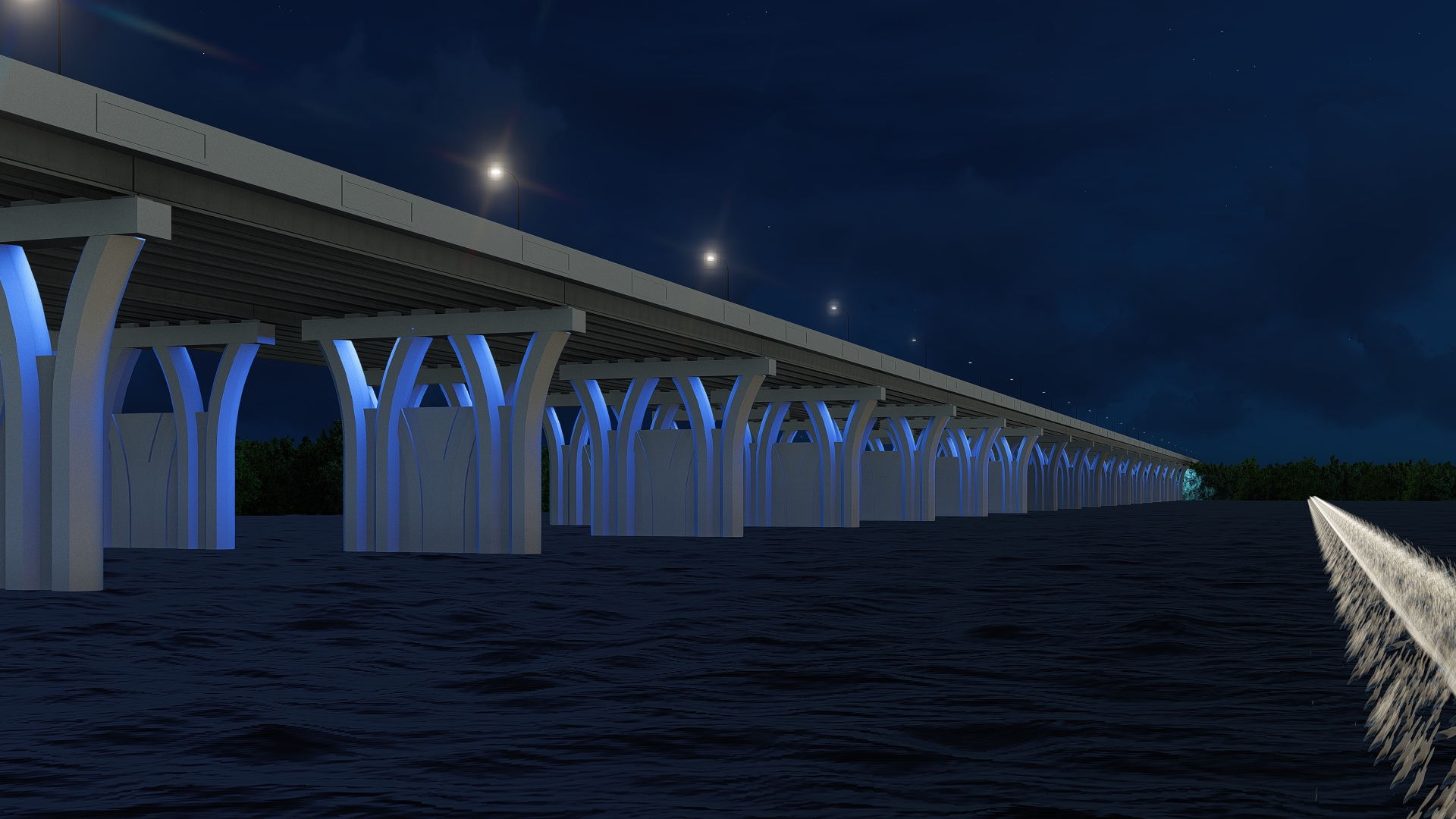 Dock Street dam shown on the right side of the image.
Dock Street dam shown on the right side of the image.
Closeup from the Riverwalk on the east shore at sunset of multi-girder bridge alternative.
 Dock Street dam shown on the right side of the image.
Dock Street dam shown on the right side of the image.
Alternative B is a concrete segmental box bridge design. A few views of the Alternative B design are shown below.
Bird's eye view in daytime of concrete segmental box bridge design from the west shore.
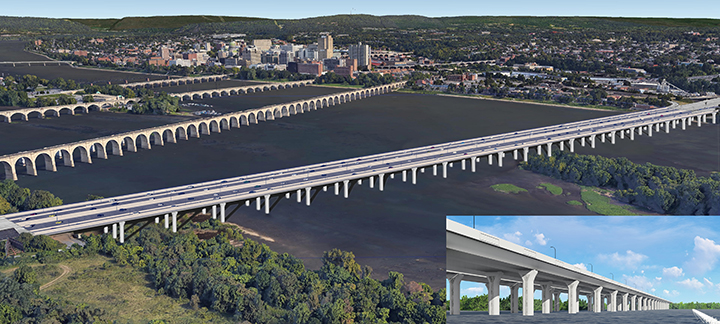
Closeup from the Riverwalk on the east shore during daytime of concrete segmental box bridge design.
 Dock Street dam shown on the right side of the image.
Dock Street dam shown on the right side of the image.
Closeup from the Riverwalk on the east shore during nighttime of concrete segmental box bridge design.
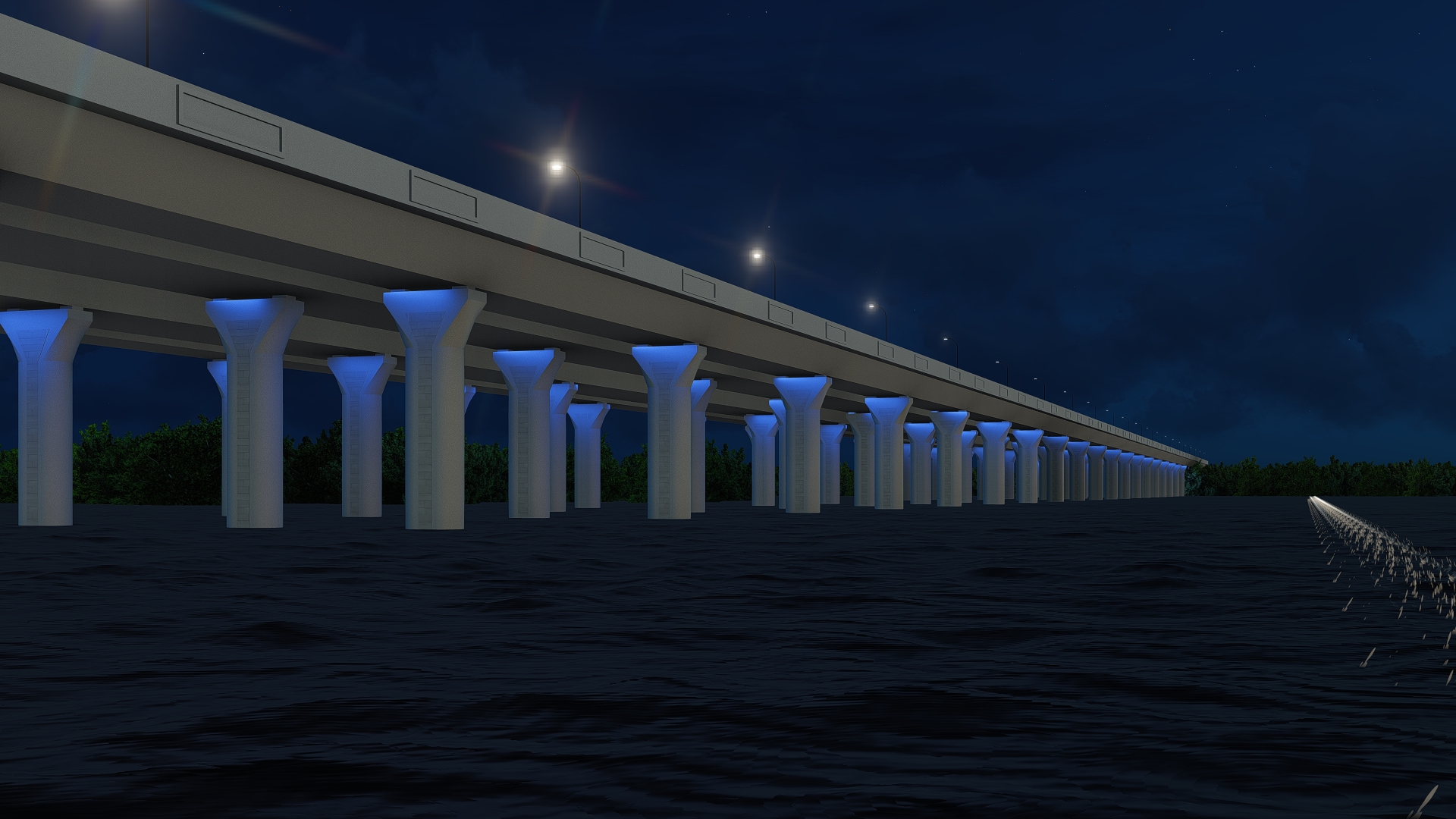 Dock Street dam shown on the right side of the image.
Dock Street dam shown on the right side of the image.
Closeup from the Riverwalk on the east shore at sunset of concrete segmental box bridge design.
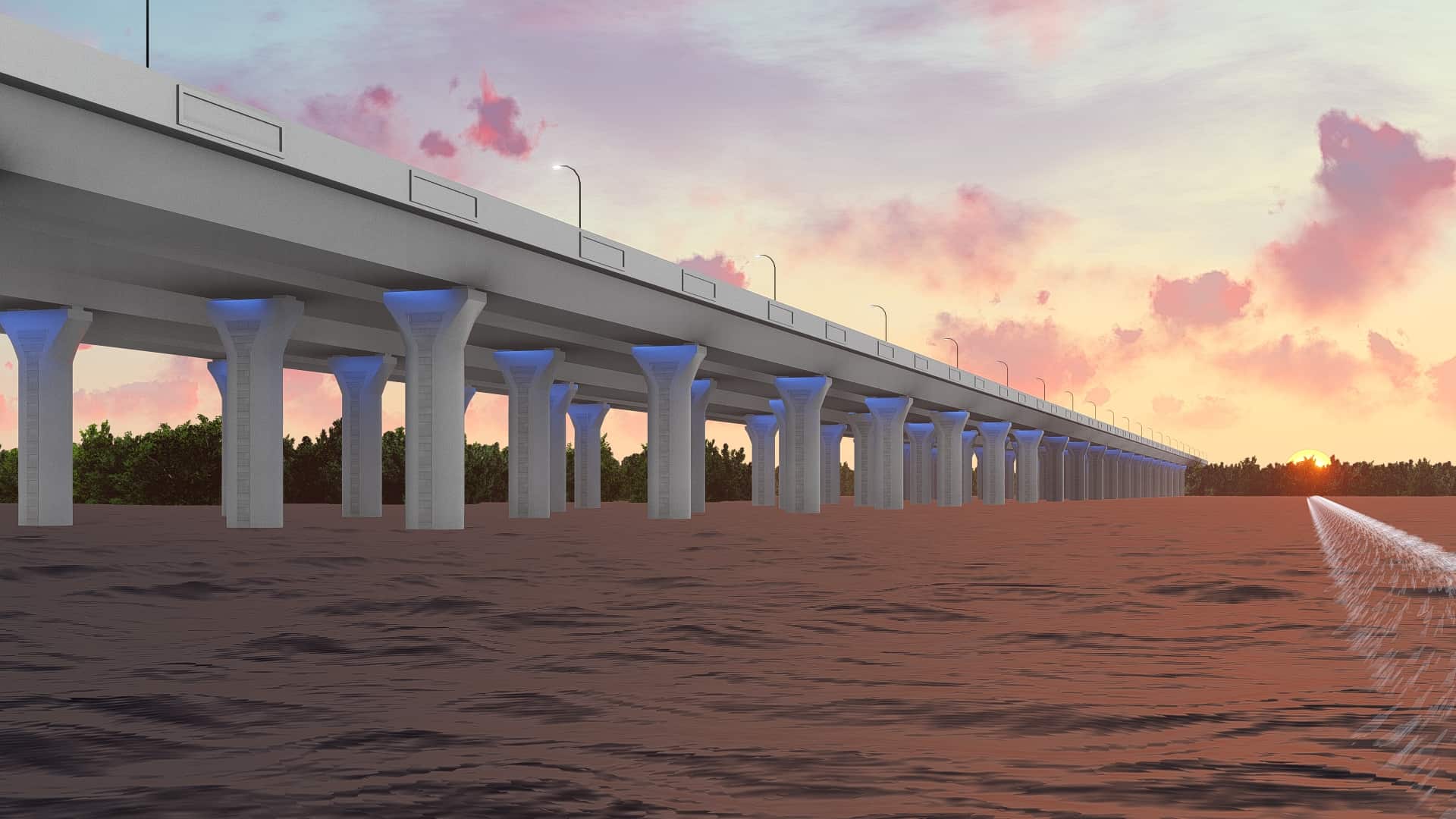 Dock Street dam shown on the right side of the image.
Dock Street dam shown on the right side of the image.
The project design on the west shore and bridge would have a consistent aesthetic design with the rest of the I-83 corridor. The images below show an example of the design aesthetic along the I-83 corridor.
Overall elevation of the bridge spanning I-83. This bridge (SR 22 Jonestown Road) would look very similar to South Third Street over I-83 on the west shore.
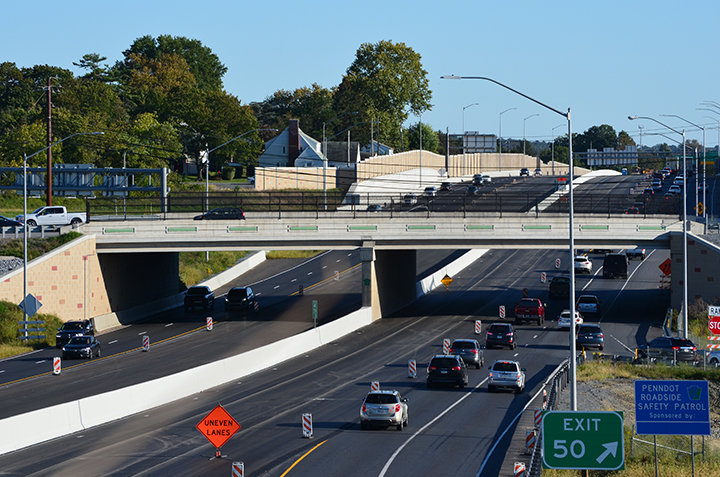
Closeup of the architectural treatment and protective fence along the length of the bridge.
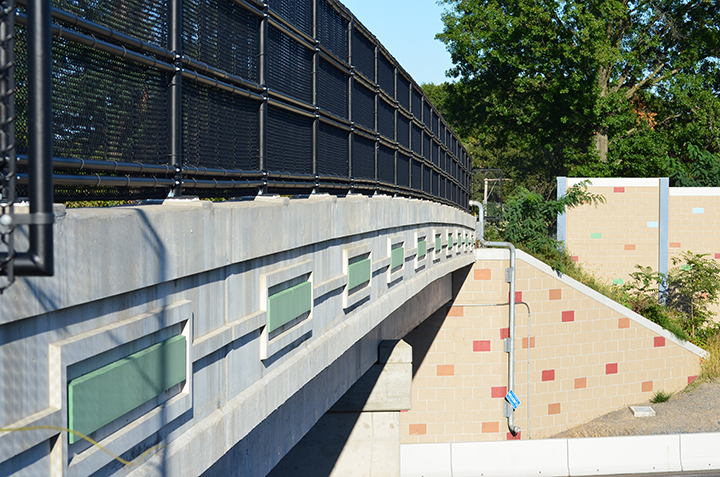
Bridge Tolling
Funding
The estimated cost of construction of the I-83 South Bridge Project is between $850 million and $1 billion.
PennDOT Pathways is a program to identify and implement alternative funding solutions for Pennsylvania's transportation system. As Pennsylvania's mobility needs have grown, the amount of funding required to support our transportation system has continued to increase. Much of our current funding comes from gas taxes and driver and vehicle fees. While this model worked well in the past, circumstances today have made it unsustainable. With PennDOT Pathways, we're looking for reliable, future-focused funding solutions that will meet our growing needs while serving our communities and all Pennsylvanians for generations to come.
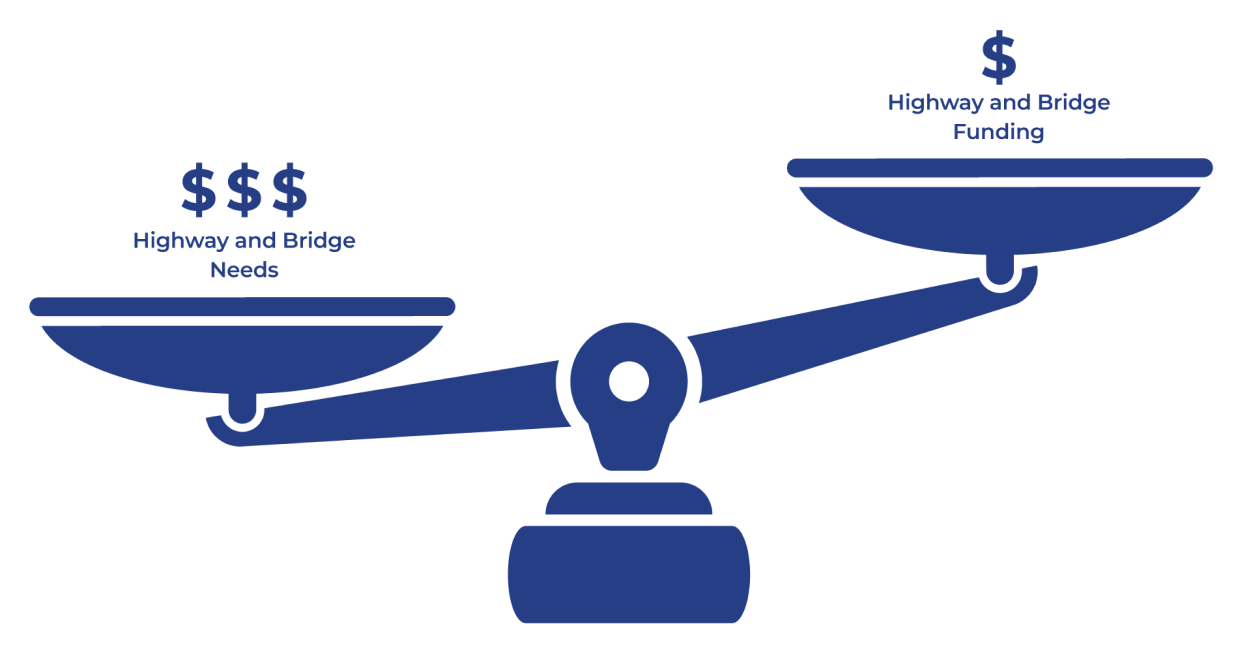
PennDOT currently faces an $8.1 billion gap in highway and bridge funding. This means we aren't generating enough funds to properly maintain, restore and expand our transportation system. PennDOT is taking action to find reliable sources of funding through the PennDOT Pathways program.
For more information about PennDOT Pathways, visit www.penndot.pa.gov/funding.
One of the funding solutions identified in the Planning and Environmental Linkages (PEL) Study is the implementation of bridge tolls on major bridge projects across the state. The I-83 South Bridge Project is one of several projects being evaluated as a candidate for bridge tolling as a part of the PennDOT Pathways Major Bridge P3 (MBP3) Initiative. You can learn more about the program and initiative at the link above.
A bridge toll is a fee that drivers pay when using a specific bridge, often by using a service like E-ZPass. The funds received from this toll would go back to the South Bridge to pay for its construction, maintenance, and operation.
Toll Implementation
To implement the toll with All-Electronic Tolling (such as E-ZPass or toll-by-plate), tolling gantries would be installed to collect tolls from vehicles travelling northbound and southbound across the bridge. These toll gantries would not require drivers to stop to pay a toll when using the bridge but would record vehicles as they pass under the gantry sensor. The toll gantry location is shown on the map below.
Signs would be placed prior to the tolling facility in each direction to inform drivers about the toll bridge, as well as at the interchanges and along the local roadway network.
PennDOT has established that tolls on the candidate bridges, including the I-83 South Bridge, would be in the range of $1-$2 for cars using E-ZPass and higher for toll-by-plate and for medium or heavy trucks. Exact tolling amounts would be determined once design plans are finalized so the toll would generate enough revenue for the bridge's replacement and maintenance for a period of approximately 30 years. At the end of the 30-year term for the Public Private Partnership (P3), the tolling facility would be removed.
Qualifying emergency vehicles would be permitted to use Major Bridge Public-Private Partnership (MBP3) bridges at no cost, following the Pennsylvania Turnpike Policy (PDF).
It is expected that toll collection on the bridge would begin between 2023 and 2025.
 Click to view toll gantry location map larger.
Click to view toll gantry location map larger.
Environmental Studies
Environmental Assessment
An Environmental Assessment (EA) is a detailed study into how a project would affect the surrounding community's quality of life, including your health, safety, cultural resources, natural resources and more. The EA is available now for public comment and review and was prepared in accordance with the National Environmental Policy Act (NEPA).
Your input is an important component of the EA.

Section 106 (Cultural Resources)
Section 106 of the National Historic Preservation Act is applicable to federal agencies and requires identification of, and assessment of effects on, historic properties and archaeological sites listed on, or eligible for listing on, the National Register of Historic Places (NRHP). Consultation with persons interested in the historic and archaeological properties/sites is integral to the Section 106 process and the project's public involvement. The Section 106 process includes identifying an area of potential effect (APE) for the project, and inviting property owners within that APE, as well as historical societies and others to participate in the Section 106 process as "Consulting Parties."" Separate APEs are established for the archaeological investigations and for above-ground historical properties.
The APE for the project was established in October 2020 and a survey was conducted of the identified properties over 50 years old within the APE. Subsequent expansions of the APE in May 2021 and for inclusion of the viaduct and Front Street/2nd Street interchange included additional properties in the survey efforts. After identification of potential historic properties and submittal of the eligibility materials, the list of historic properties within the APE was finalized to include:
- Harrisburg Historic District (downtown Harrisburg and Shipoke)
- Pennsylvania Railroad: Enola Branch Low Grade Freight Line (West Shore along Susquehanna River)
- Pennsylvania Railroad: Mainline (East Shore in Harrisburg)
- Harrisburg City Parks 7 Parkway Plan (includes the Greenbelt and Riverfront Park)
- West Shore National Bank of Lemoyne (Lemoyne Borough)
- Philadelphia & Reading Railroad: Harrisburg & Pittsburgh Branch, Philadelphia to Harrisburg (Lemoyne Borough and Harrisburg
- Grace United Evangelical Church (Lemoyne Borough)
- Henry T. Simmonds House (New Cumberland Borough)
- Calvary Presbyterian Church (East Shore in Harrisburg)
- Paxton Fire Station (downtown Harrisburg)
 Click to view APE map larger.
Click to view APE map larger.
With the presence of historic properties within the APE, the project has been evaluated in accordance with Section 106 regulations of the National Historic Preservation Act and the Pennsylvania State History Code. Through this evaluation and coordination with the State Historic Preservation Officer (SHPO), it was determined that the project would result in No Adverse Effect to historic properties.
After initial design activities were conducted, areas that were previously undisturbed were investigated for the potential to contain archaeological deposits. No archaeological deposits were found in the geomorphological and archaeological investigations conducted for the project. It has been determined that there are no archeological resources in the project area.

Noise Analysis
Since new lanes are being added northbound and southbound and the Lemoyne and Front Street/2nd Street interchanges are being reconstructed, the I-83 South Bridge Project is eligible for consideration of noise abatement. A noise analysis was conducted and included noise monitoring of existing conditions and noise modeling for future conditions. Noise modeling was performed to predict noise levels throughout the project area under worst-case, peak-hour traffic conditions.
The noise analysis studies included existing conditions in 2016, conditions in 2050 under a no-build scenario, and conditions in 2050 with the new bridge project design.
Throughout the project corridor, four noise study areas (NSA) approached or exceeded PennDOT and FHWA's Noise Abatement Criteria (NAC) warranting abatement consideration. These are labeled as NSA 2, NSA 3, NSA 4 and NSA6. Based on meeting the criteria, an evaluation of noise abatement was conducted for these four locations.
Through the noise abatement evaluation analysis, it was determined that sound barriers were both feasible and reasonable for two of the locations, NSA 2 and NSA 3. It was determined that noise abatement was not feasible and/or reasonable for the other two locations, NSA 4 and NSA 6.
With these results, additional analyses are recommended for NSA 2 and NSA 3 during the final design phase of the project.
The parameters of warranted, feasibility, and reasonableness are explained below:
- Warranted: Noise abatement is warranted in areas approaching or exceeding the NAC due to traffic noise at noisesensitive land uses within the project corridor.
- Feasibility: Where warranted, noise abatement feasibility looks at the effectiveness of a noise barrier in reducing noise, and the ability to construct without introducing substantial engineering or safety problems to the project
- Reasonableness: If noise abatement passes the feasibility test, the reasonableness is evaluated to ensure that a noise barrier is appropriate for a given area or project by assessing cost/benefit, noise reduction goals, and the consideration of viewpoints from the benefitted receptors. If it passes the reasonable test, benefitted receptors of the noise barrier would cast a vote on if they would like to have a noise wall constructed. If the vote passes by a majority, a noise barrier would be constructed.
For reference to the previous East Shore Section 3 Noise Report to see information about initial studies for the viaduct, click here.

Air Quality
It is PennDOT's policy to assess the air quality impacts of transportation improvement projects and to give consideration to the incorporation of appropriate avoidance and/or relief strategies into preliminary engineering designs and construction for those projects that have potential air quality impacts. An air quality analysis has been conducted for this project in accordance with US Environmental Protection Agency's (EPA), Federal Highway Administration's (FHWA) and PennDOT's approved Air Quality protocols and procedures. The analysis evaluated the air quality impacts of the project relative to national ambient air quality standards. This includes an analysis of:·
- Whether the project will cause or contribute to a new localized exceedance of carbon monoxide (CO) or particulate matter (PM2.5) ambient air quality standards or increase the frequency or severity of any existing exceedances.
- The potential for Mobile Source Air Toxics (MSATs) impacts due to the project.
- The greenhouse gas (GHG) impacts of the project.
After the analysis was conducted, it was determined that the project would have no significant adverse impact on air quality in any of these categories.
Waste Studies
A Phase I Environmental Site Assessment Report (ESA) was conducted for the project study area. The Phase I ESA included record reviews, interviews, site reconnaissance, compilation of data, data evaluation, and recommendations. Fourteen sites were identified that will require further investigation as the project progresses.
 Click to view the West Shore waste map larger.
Click to view the West Shore waste map larger.
 Click to view the East Shore waste map larger.
Click to view the East Shore waste map larger.
Nineteen total sites were identified in the project area. Site 8 on the West Shore and Sites 1,5,8 and 12 on the East Shore did not require further investigation as no earth disturbance was anticipated.

Wetland and Stream Studies
Wetland studies were completed for the project and a Wetland Identification and Delineation Report was prepared to meet the regulatory requirements of the U.S. Army Corps of Engineers (USACE) under Section 404 of the Clean Water Act and in accordance with the Pennsylvania Department of Environmental Protection (DEP). In this report, it was identified that the project area includes the Susquehanna River and Paxton Creek waterways and three river island wetland areas.
Impacts to the river island wetlands are shown in the table below:
| River Island Wetlands Impacts |
Impact |
| Permanent |
0.3 Acres |
| Temporary |
0.04 Acres |
 Click to view wetlands map larger.
Click to view wetlands map larger.
The Susquehanna River is a warm water fishery. Migratory fish species are known to move upstream to spawn. These fish pass the Dock Street Dam via notches in the dam, which will be maintained during construction.
Paxton Creek has an extensive 100-year floodplain, which in combination with the Susquehanna River, covers much of the east shore within the study area. The Paxton Creek floodway is mainly confined between the Amtrak rail corridor on the west and 10th Street on the east.
Floodplains
The new South Bridge would not increase the flood elevations in the project area. During construction of the project, access in the river would be needed for constructing the bridge. PennDOT is coordinating with relevant regulatory agencies to minimize flooding impacts due to construction activities. Reconstruction of the viaduct would span Paxton Creek and would not impact floodplains in the area.
Threatened & Endangered Plants & Animals
A review determined there are no known impacts anticipated to threatened and endangered plants and animals within the project area.
Right of Way Acquisition
Where the project requires acquisition of ROW, property would be purchased in accordance with the Uniform Relocation Assistance and Real Property Acquisition Policies Act of 1970.
More information can be found in the following publications:
Traffic Diversion
Traffic diversion analysis comprises two distinct steps: The first is the development of the traffic model to predict how much traffic would divert off the interstate when a toll is imposed and what route that traffic would take. The second step is evaluating and analyzing the diversion routes identified to determine the impact of the diverted traffic on that route and to identify improvements to mitigate those effects.
A detailed traffic demand model was used to identify diversion routes. The existing Tri-County Regional Planning Commission Harrisburg area model that was employed is based on assumptions around the transportation system, regional demographics, and traveler characteristics. These assumptions were then combined using data from traffic counts (including the share of truck traffic), recorded travel speeds and origin and destination patterns, along with regional travel demand models. Both short- and long-term effects were evaluated.
The model is then run under various parameters to predict the amount of traffic that may choose to divert off the interstate and more importantly, where that traffic would go.
If a toll is placed on the I-83 South Bridge Project, an estimated 23 percent of daily traffic is expected to choose to divert off the interstate to avoid paying the toll, based on the results of the detailed traffic model. The model was also used to analyze what routes they would predominantly take. These would be predominantly passenger vehicles and small trucks.
So where does the majority of the diverting traffic go? The primary diversion routes identified are the I-81 Bridge, I-76 Bridge, Harvey Taylor Bridge and Market Street Bridge. These routes are shown in the map below. You can click on the map to enlarge it.
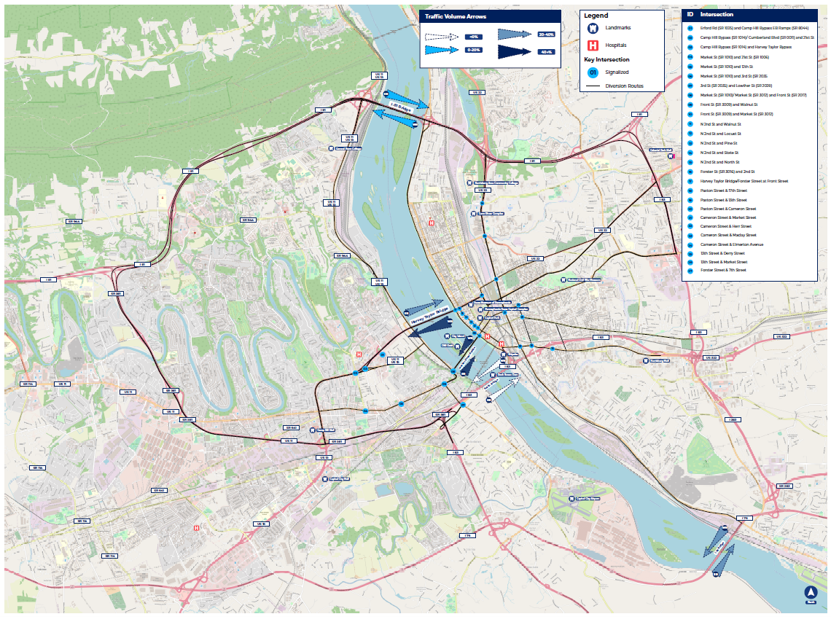 Click to view diversion map larger.
Click to view diversion map larger.
As you can see from the table below, the PM peak hour traffic on South Bridge would be reduced by approximately 1,800 hour in each direction. What does this mean for the other bridges in the area? The table shows the estimated change in traffic volume across the Harvey Taylor Bridge, I-76 (Turnpike) Bridge, I-81 (Wade) Bridge, and the Market Street Bridge. The vehicles that divert from South Bridge use one of the other four bridge crossings. PM peak hour traffic will increase in the range of 400-500 vehicles per hour in each direction for I-81 and I-76.
Some traffic that was likely using South Bridge to avoid the turnpike toll would return to the turnpike. Harvey Taylor Bridge will see ranges of about 350-670 vehicles per hour, and the Market Street Bridge will see up to 280 vehicle per hour increase in the westbound direction during the PM peak hour. The peak hours are used to evaluate the operations at intersections during the busiest times of the day.
PM Peak Hour Traffic Volume Table
| Bridge |
Direction |
Pre-Toll Traffic |
Post-Toll Traffic |
| South Bridge (Northbound) |
Eastbound |
6,850 |
5,230 |
| South Bridge (Southbound) |
Westbound |
7,880 |
6,310 |
| I-81 Bridge (Northbound) |
Eastbound |
4,410 |
4,930 |
| I-81 Bridge (Southbound) |
Westbound |
6,620 |
7,080 |
| Harvey Taylor Bridge |
Eastbound |
1,270 |
1,620 |
| Harvey Taylor Bridge |
Westbound |
1,840 |
2,510 |
| Market Street Bridge |
Eastbound |
560 |
840 |
| Market Street Bridge |
Westbound |
940 |
940* |
| I-76 Bridge |
Eastbound |
1,800 |
2,260 |
| I-76 Bridge |
Westbound |
2,320 |
2,840 |
*Due to capacity constraints at this intersection during the PM Peak Hour, the model has predicted that volumes will remain the same.
Using the traffic demand model, the origin-destination patterns are also taken into account in looking at diversion. The origin-destination criteria is divided into three categories, local (<10 miles), regional (10-25 miles) and external (<25 miles). As you can see in the graphic below, the majority of the traffic traveling over the bridge is local traffic.
Traffic Demand Model
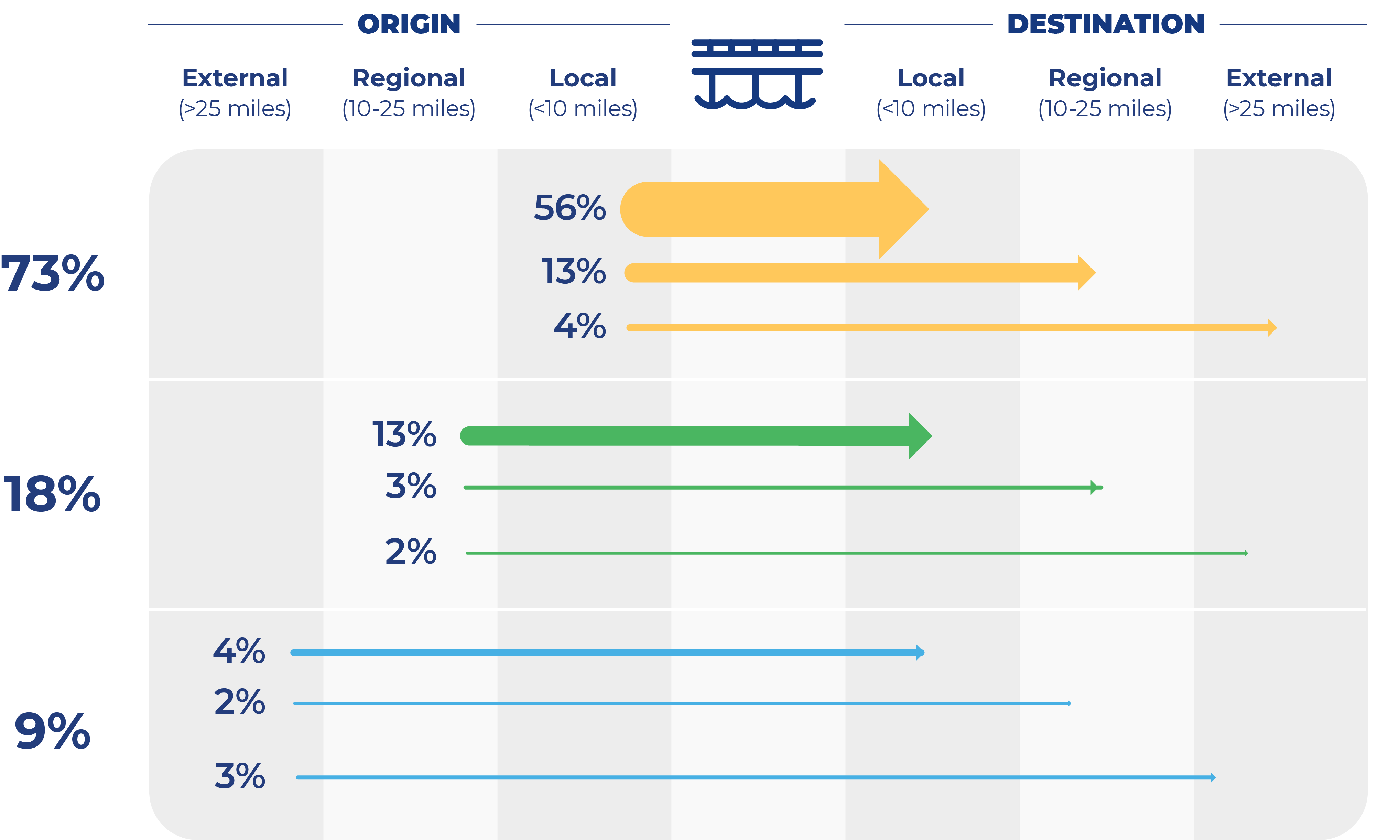
When people hear about vehicles diverting from the interstate to avoid a tolled bridge, they often envision what happens when there is a full traffic detour. To distinguish between a diversion and a detour in simple terms, diversions are a choice, detours are mandatory.
Detours are imposed because of construction or an incident on a roadway or bridge and those detours must be followed. In contrast to a detour, diversion from the interstate is a choice that drivers may make to avoid a toll and the diversion traffic is normally a small fraction of the number of vehicles compared to detours, when 100 percent of traffic leaves the interstate.
Traffic Diversion Methodology
Once it was determined how much traffic would divert and the primary route that would be utilized, a comprehensive evaluation of the impacts to the diversion route was undertaken. The graphic below highlights the key methodology for the evaluation of the diversion route.
Route Identification
Prioritize routes that add more than 100 vehicles per day
Traffic Projections
No toll vs. tolling scenario comparisons
Route Conditions
Intersections, traffic control, signage, & pavement conditions
Crash Data Summary
Identify crash patterns & crash rates
Capacity Analysis
Depict operational issues & capacity limitations
Roadway Review
Evaluation of lane widths and pavement structure
Alternative Transportation Modes
Transit, bus, bike lanes, etc.
Potential Mitigation Options
Evaluation of options to offset impacts to community
A workshop was conducted with key stakeholders in July 2021 to get feedback on the diversion route analysis and collect additional information on routes drivers might take, and potential impacts from diverting traffic. This feedback was incorporated into the traffic diversion analysis and evaluated to identify improvements PennDOT could consider to mitigate effects on the community caused by toll diversion.